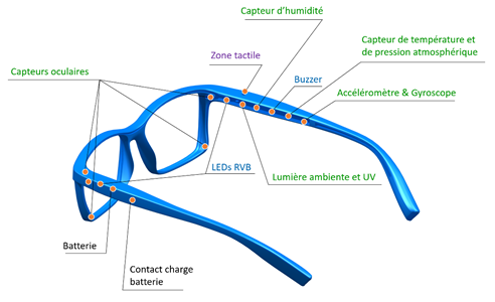
Study and design of digital devices for sensory substitution and extended cognition
About the Project
In recent years, the massive growth in the number of connected devices has led to changes in usage and behaviour among their users. After integrating our everyday devices and transport systems, miniaturized digital systems have been able to offer services as close as possible to the human being. Initially worn for sports or medical surveillance purposes, these devices will soon be incorporated as prostheses in order to compensate for certain deficient organs, or even to increase certain perceptual or cognitive functions. The question then arises of their learning, appropriation, and integration into their daily environments by those who use them.
The question will arise all the more with future digital systems in the still prototype state, which will behave like brain extensions to aid cognition or sensory substitution. The possibilities of these new, technologically advanced connected objects already amaze as much as they frighten. Today, converging technological advances in miniature antennas and low-power electronics have made it possible to develop innovative systems within UCA whose services (location or monitoring) are transforming the activities where they are implemented. Tomorrow, this effect will be multiplied with the next technologies developed in the LEAT laboratory, which will be able to combine AI and artificial electronic neural networks capable of learning or even to directly communicate with biological neurons. The partners in the ARTEFACT project propose that this subject, often imposed by industrial companies or simplified by the media, should finally be treated and reappropriated by the University in an interdisciplinary manner.
ARTEFACT brings together researchers and teacher-researchers in electronics, sociologists, psychologists, computer scientists and neuroscientists. The objective is to go from the design of new devices to the support of their implementation. One thesis will focus in particular on the interconnection of biological neurons - artificial neurons in order to compensate for deficient cognitive functions in the long term, such as the sense of balance for example. In parallel, the team will build hypotheses to think and anticipate applications, on the psychological, social and ethical levels, by answering questions of functionality, experience and acceptability, i.e.: How does the human-prosthetic system operate? What is the experience with such a device? How does human-prosthetic coupling fit into real application contexts? To this end, ARTEFACT will identify devices sufficiently close to the future technology on the precise dimensions that the team wishes to explore. Then it will be necessary to submit to experimentation, in laboratory and natural situations, these devices acting as digital artefacts with an increasing level of cognitive assistance (scafolding)
- Principal Investigator
- Project's partner(s)
-
- Laboratories
- Bernard Conein, MSHS, UCA / USR 3566 CNRS
- Manuel Boutet, Gredeg, UCA / UMR 7321 CNRS
- Alexandre Muzy, I3S, UCA / UMR 6070 CNRS
- Franck Grammont, LJAD, UCA / UMR 7351 CNRS
- Xavier Corveleyn, LAPCOS, UCA / UMR 7320 CNRS
- Yoshiho Ikeuchi, Université de Tokyo
- Industrial Partners
- Ellcie-Healthy
- Abeeway
- Laboratories
- Duration
-
- October 2018- September 2021
- Total Amount
-
- 208 000 euros
- Publications
-
- RASAMUEL, Marino, GAFFÉ, Daniel, LEVI, Timothée, et MIRAMOND Benoît. Synchronous approach for modeling spiking neurons. In : 2019 IEEE Biomedical Circuits and Systems Conference (BioCAS). p. 1-4. IEEE, 2019.
https://hal.archives-ouvertes.fr/hal-02276306
- RASAMUEL, Marino, GAFFÉ, Daniel, LEVI, Timothée, et MIRAMOND Benoît. Synchronous approach for modeling spiking neurons. In : 2019 IEEE Biomedical Circuits and Systems Conference (BioCAS). p. 1-4. IEEE, 2019.
- Related Documentation
-
- Project ARTEFACT presentation (Day of projects restitution of the Academy “Networks, Information and Digital Society", 14/03/2022)
- French Television Report - France 3 (November 2019)
- Project's Presentation delivered at the DS4H Scientific Day (September 2018)

